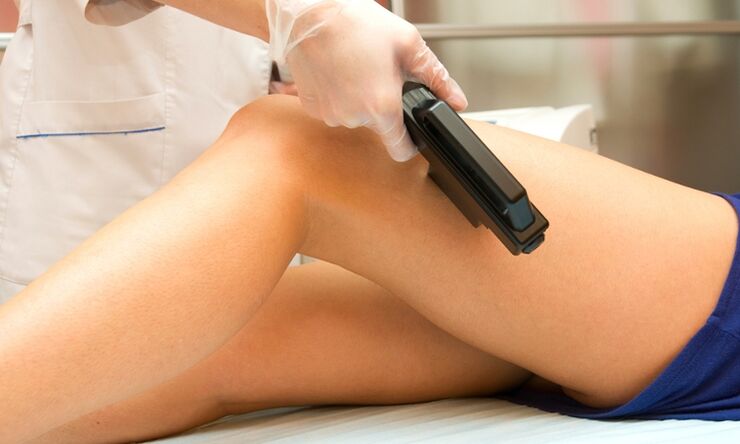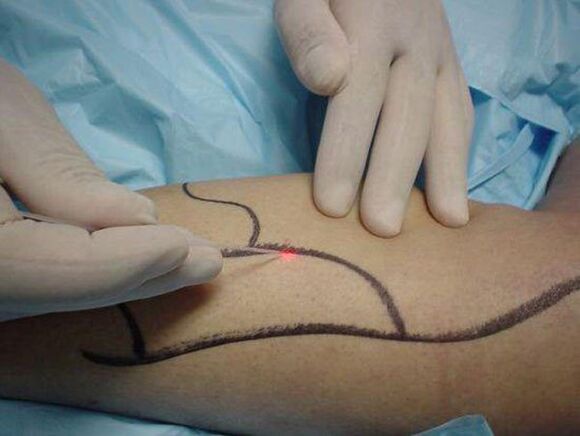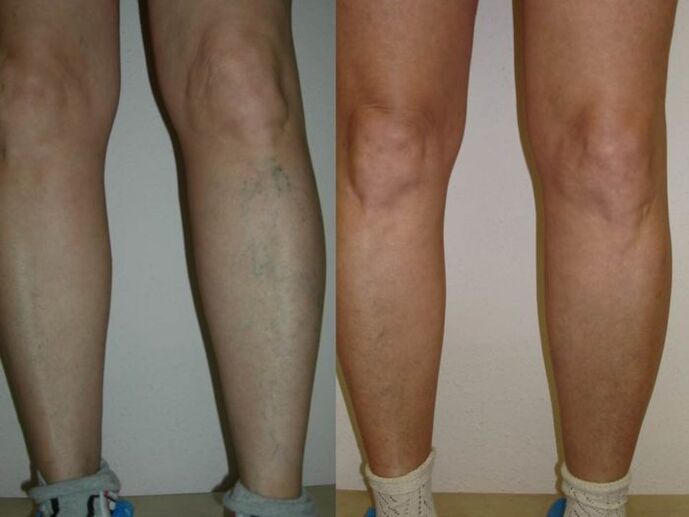Varicose veins on the legs are a common pathology that occurs in people of different sexes and ages, regardless of the country of residence. For a long time, the only way to get rid of dilated veins in the lower extremities was through surgery. But today, doctors offer a painless and effective method - laser treatment of varicose veins.
The essence of the procedure comes down to the introduction of a special light guide into the vessels, under the influence of which the damaged vessel will stick, and the blood flow will be directed through healthy veins. If we consider alternative therapies, then:
- classical vein removal (phlebectomy) is characterized by pain and trauma, there is a risk of infectious complications;
- removing only part of the diseased vein (microflebectomy) leaves scars on the skin;
- sclerotherapy causes allergies in some cases.
Considering the listed disadvantages, which laser lacks, it is the laser treatment of varicose veins that is rightly called the best option among those that exist. Doctors have been practicing this method for over 10 years, and during this time, the laser coagulation did not cause any complaints. Not everyone can afford the price, but if one takes into account the efficiency of the procedure, it is quite possible to accumulate the required amount or take out a loan.
Indications for laser coagulation
The procedure is indicated in the presence of large and small dilated saphenous veins. In addition, the expansion of the vascular bed should not exceed 1 cm, and the veins themselves should be mostly regular, without pronounced curvature. The branches of the veins should be healthy or slightly dilated. In other words, laser coagulation is effective at the initial stage of varicose veins, when the severity is low, and this only applies to the superficial veins. As for veins dilated by more than 1 cm, they can also be "stuck" to the laser, but there is a risk that in the future the vessel will detach again and that all treatment will be lost.

The laser acts on a small area, which eliminates the negative impact on adjacent tissues. For this reason, in case of severe damage to the blood vessels and to the deep veins, the laser is not effective. In such situations, choose one of the classic methods listed above.
Contraindications to laser treatment
In addition to the cases listed above, when the technique becomes ineffective, endovasal varicose vein laser coagulation is contraindicated in situations where it can harm the patient. There are enough contraindications, and they are all divided into relative and absolute.
The relative ones include the contraindications which, at this moment only, do not allow to perform the operation. It can be burns and inflammation of the skin, exacerbations of chronic pathologies. It is necessary to remedy the current problem, and then proceed with the removal of the veins with a laser. If you do the reverse, the risk of complications is high. Pregnancy and hepatitis B are also considered relative contraindications, since during this period the body is weakened and the load on the legs is heavy. Due to congestion of the veins of the lower extremities, the operation is not performed in obese people - complications are likely.
Absolutes include contraindications, due to which a person is prohibited from laser removal. These are the following states:
- damage to the walls of blood vessels;
- disturbed flow of lymph and blood in the legs;
- thrombophlebitis and tendency to thrombosis.
Against the background of such conditions, the laser can cause venous thrombosis and damage blood vessels. Other contraindications relate to the lifestyle of people - if it is not possible to actively move and wear compression underwear in the future (after surgery), the vessel may s'inflame and treatment will be ineffective.
How does the procedure take place
Treatment of varicose veins on the legs with a laser is carried out on an outpatient basis. General and local anesthesia is not necessary, since the area of influence is very small and the process takes place inside the blood vessel. If necessary, you can take a sedative on the recommendation of a doctor if you are concerned about surgery. The main part of the procedure:
- a small incision is made on the skin of the leg through which a light guide is inserted into the damaged vein. This fixture will emit laser light at a controlled wavelength;
- due to radiation, blood is forced out of the damaged vein;
- under the influence of the laser, the walls of the vessel stick together, the blood no longer circulates there.
Typically, laser treatment takes up to 90 minutes. After the damaged veins are sealed, the blood is directed to the deep veins located inside the muscles. After such a procedure, there are no scars and bruises.
Benefits of laser therapy
As mentioned at the beginning of the article, compared to other methods, laser varicose vein removal has many advantages. Everyone should know the main advantages:
- it is not necessary to go to the hospital, since the procedure is carried out on an outpatient basis, on the same day you can go home;
- the procedure gives the best cosmetic effect, since the doctor reaches the affected vein with a small puncture on the skin, which will then heal without scarring and scarring;

- Modern laser equipment diffuses the radiation well, allowing high-quality treatment inside the vessel. This eliminates the risk of bleeding and bruising;
- it is possible to immediately remove the veins from both legs;
- the rehabilitation period is very quick and painless. An hour after the procedure you can go home and after a few days live the same life.
Considering the listed benefits of the procedure, it becomes clear why the treatment of varicose veins by laser coagulation is recognized as the most effective and the safest. After that, there is no thrombophlebitis and secondary infection, scarring and discomfort, complications and relapses.
Disadvantages of laser vein treatment
Any medical manipulation has, in addition to advantages and disadvantages. When removing veins from the legs, laser treatment is also not always cloudless. More precisely, before the procedure, you should familiarize yourself with the difficulties and possible disadvantages of the technique:
- a severe stage of varicose veins is not treated with laser;
- with a large diameter of the damaged vessel, laser therapy is combined with surgery, and incisions and marks on the skin can not be done without;
- laser treatment for varicose veins involves wearing compression stockings for a week (at least) after the operation, which not everyone likes;
- The main drawback is considered by many to be the high price of laser procedures.
After weighing the advantages and disadvantages mentioned, you can discuss with your doctor the best way to treat varicose veins in a particular case.
Rehabilitation
There are no special measures to restore health after laser coagulation of the veins. The patient quickly returns to normal life. Hospitalization is not necessary, as is bed rest. The same can be said of taking antibiotics, physiotherapeutic procedures and tightly bandaged legs, like those of a mummy - the modern procedure is completely free from these flaws.
At the end of the operation, the doctor allows the patient to get up gradually. First you need to sit on the sofa for a while in order to normalize your condition, after which you can get up. Strong elevation after an hour of rest on the sofa is not recommended, as it can cause vascular collapse, dizziness, etc.
The patient does not feel pain in the legs when transferring weight to them. The only thing that can bother you is a slight tingling sensation in the place of the leg through which the light guide has been inserted. Since there is no pain syndrome, you do not need to take pain relievers.

A prerequisite for the rehabilitation period will be the wearing of compression stockings. The duration of wearing these underwear and the degree of their compression should be discussed individually with the doctor. Thanks to the compression stockings, the pockets are eliminated and the blood flow in the superficial veins is stopped, their role is taken over by the deep blood vessels. Compression garments purchased in advance are put on the patient's legs directly in the operating room after the end of laser coagulation.
In the first 2 days after the operation, the compression stockings are left on the legs even at night, then worn during the day for the entire period recommended by the doctor, and removed at night. Considering that the compression tights will warm the body, it is advisable to do the procedure in the cold season. This way, you can avoid the discomfort and the need to wear tights on a hot day.
Physical activity is not limited - you can walk without assistance. The only thing not to do with varicose veins and after surgery is to lift weights. During the first week, it is undesirable to visit the sauna and steam room in the bath. In the future, you will be able to safely travel long distances, drive a car and do your usual activities.
The general recommendations for anyone who has encountered varicose veins on the legs are as follows:
- control body weight, as extra pounds are a load on the spine, heart and blood vessels;
- avoid static poses. If your professional activity involves prolonged sitting or standing, you should take breaks and warm up from time to time;
- you can not sit cross-legged - it constricts blood vessels;
- you have to quit smoking forever;
- shoes should be comfortable, women's heels - up to 5 cm high;
- normalize the daily routine by supplementing it with daily walks and regular gymnastics.
By observing the listed recommendations, you can prolong the effect of the operation for a long time.












































